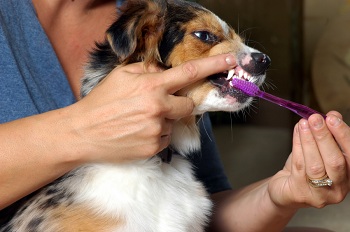
Since we were kids, it’s been drilled into our heads that we need to brush our teeth and visit the dentist for regular check-ups. Like us humans, pets need proper dental care, too.
February is Pet Dental Health Awareness Month, and veterinarians across the country will be doing their part to help increase your awareness of dental health care needs for your pet. Let’s get things started with a few tips to help you provide better oral care for your dog or cat.
- Brush early on.
Although pets don’t need much dental maintenance in the first few months of life, brushing their baby teeth helps them become familiar with the routine and be more receptive to brushing when their permanent teeth erupt. It’s okay to stop brushing while your pet is losing teeth as his mouth may be a bit sore, but don’t forget to pick up where you left off when their adult teeth are in and their gums have recovered.If you have an older pet, the training process may take a little longer but it’s worth the effort. - Brush properly.
Do not use human toothpaste or baking soda to brush your pet’s teeth – both can upset your pet’s stomach if ingested! Use toothpaste formulated specifically for pets – it’s also flavored so your pet will enjoy the taste.When you’re first starting out, your pet may be nervous so starting with a toothbrush may not go over so well. Start by putting a dab of pet toothpaste (or tuna water for cats) on your finger or a damp washcloth and gently rub his teeth and gums with it – start with the front and gradually work towards the back.Once your pet becomes comfortable with this approach, you can graduate from fingers to a real toothbrush. Pet toothbrushes are specifically angled for better reach, but either way, it’s a good idea for the bristles to be fairly soft. Some cats may even prefer a Q-tip in place of a toothbrush (dipped in tuna juice, of course). - Brush regularly.
Brushing your pet’s teeth daily is much more effective at warding off plaque and tartar build-up than only a few times a week – and, it’s an easy routine to remember if you brush his teeth each night after you’ve brushed yours. - Supplement with tooth-friendly foods and treats.
A number of commercially available pet foods are formulated to remove tartar and promote good dental health. Similarly, dental treats are widely available and may be a great option if your pet requires their current specialized food for medical reasons.Chew toys bring a lot of fun for pets and can be part of your pet’s overall dental care plan, but talk to your veterinarian first – some harder chew toys may pose more of a problem and are known to chip and fracture teeth.A list of dental products and diets that have been accepted by the Veterinary Oral Health Counsel can be found on www.vohc.org. - Visit your veterinarian annually.
Don’t skip your pet’s yearly veterinary check-up. During these annual exams, your veterinarian has the chance to look at your pet’s teeth and let you know if your current dental care plan is working or if it needs a little adjustment.And if your pet has bad breath (not just pet breath, but unusually bad breath), excessive drooling or visibly irritated gums, call your veterinarian and book an appointment. Dental problems can impact your dog’s overall health and should be addressed as quickly as possible.
It’s important to remember that our pets don’t smile like we do, so dental disease is a lot harder to recognize. So brush up on your dental awareness and put a dent in your pet’s dental health care plan.
